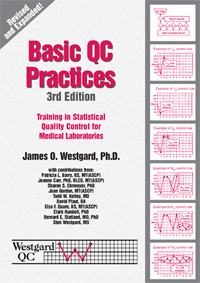Basic QC Practices
QC Practices for Molecular Testing
Historically, the first publication of the “Westgard Rules” was shown with an example from
clinical chemistry. As a result, some people believe that QC does not apply to other areas of testing, like hematology, immunology, etc. nor to the new technologies and devices that have been introduced to the laboratory in recent years. This lesson explains how QC techniques apply and can be implemented in "other" areas of testing. (Preview)
QC Practices for Molecular Testing
Joan Gordon, BS, MT (ASCP), Clark Rundell, PhD, Jeanne Carr, PhD, BCLD, MT(ASCP), and Todd W. Kelley MD
- Challenges of molecular diagnostic testing
- Proficiency Testing
- Control Materials
- Viral Load Testing
- BCR-ABL Testing
- Conclusion
All genetic diagnostic tests and most other molecular tests are classified as high complexity and as such must comply with the CLIA regulations for high complexity diagnostic tests described previously
in this book. However, compared with other laboratory disciplines, the state of the art in quality control (QC) practices for molecular diagnostic tests has fallen behind. QC for molecular diagnostic tests encounters many challenges: new and rapidly evolving technologies, high expectations of accuracy for once-in-a-lifetime genetic tests, lack of quality control materials, lack of standardized calibrators, lack of quantitative test system outputs and software to track them, and the almost daily appearance of new test targets. In the face of such issues, clinical laboratories struggle to develop appropriate quality assurance programs for the molecular diagnostic tests they conduct. The accuracy of molecular testing is currently unknown, but concerns about quality in molecular diagnostics can only be quantified and effectively addressed when reliable data are available. Although monitoring molecular test system outputs and applying statistical analysis provide a good way to obtain data on accuracy and precision, such traditional QC strategies which have been used historically in other laboratory disciplines have been slow to take root in molecular diagnostics.
The laboratorians’ experience and knowledge, availability of QC materials, capabilities of test systems, test costs, and regulatory requirements have an impact on current QC practices. The earliest molecular tests were done manually and the results were determined by interpreting the presence or absence of bands on a gel. Such testing was often performed by researchers with minimal experiencein traditional QC techniques, and the QC materials consisted of previously tested patient samples. Monitoring for systematic errors was deemed to be unnecessary because test failure was easilydetected. Furthermore, since the QC materials were variable, labs did not know if a change in band intensity meant an enzyme was degrading or the selected patient control samples did not containenough DNA. Once failure occurred, the labs had to trouble-shoot and retest all of the patient samples as required by regulations. Even though the cost of doing so was a day’s work, the reagents were inexpensive, physicians did not expect a fast turn-around time, and the system was relatively easy to trouble-shoot. However, molecular test systems are now more complex and expensive, and physicians expect quicker results. Since samples for genetic molecular tests can cost at least $40 each and workloads have increased, retesting is a significant problem. The traditional QC practice of using homogeneous (consistent lot to lot) QC materials could be useful for molecular diagnostics in identifying degrading or defective system components before an actual test failure. Faced with the limited commercial availability of QC materials, some labs pool patient samples to create a reproducible source of such materials.[1] Furthermore, new molecular systems have quantitative outputs, such as fluorescence (signal strength) or allelic ratio, which can be tracked to monitor test system performance. Statistical analysis of the QC results over time can establish expected variations. Such results can then be serially plotted on Levey-Jennings charts to monitor the test system for shifts or trends in performance. “Westgard Rules” can be applied to determine when corrective action should be taken to prevent test failure.
These traditional QC practices satisfy best practice and CLIA regulations. Particularly pertinent to QC practices but often not stringently followed by molecular labs are CLIA Sections §493.1201:
The laboratory must establish and follow written QC procedures for monitoring and evaluating the quality of the analytical testing process of each method to assure the accuracy and reliability of patient test results and reports and §493.1256: For each test system, the laboratory is responsible for having control procedures that monitor the accuracy and precision of the complete analytical process, and The control procedures must – (1) Detect immediate errors that occur due to test system failure, adverse environmental conditions, and operator performance.(2) Monitor over time the accuracy and precision of test performance. As in other laboratory disciplines, molecular QC should monitor all test components including the extraction step and the material should be homogeneous so that shifts and trends of QC results can be assumed to be due to the test system, not the QC material.
 We invite you to read the entire lesson.
We invite you to read the entire lesson.
To read a complete version of this article, we invite you to purchase the Basic QC Practices manual, Third edition.
